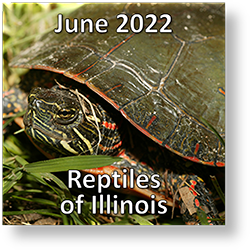 What are Reptiles?
What are Reptiles?
Reptiles are animals that have a backbone, dry skin and are covered with scales or bony plates. Their body temperature is controlled by the outside temperature and by their behavior. They have four limbs, or their ancestors had four limbs.
These organisms develop from an amniotic egg, which is either deposited on land or retained within the female for the extent of its development. The egg provides everything the embryo needs to develop. The shell of a reptile egg deposited on land is leathery. Fertilization is internal.
The reptiles in Illinois are turtles, snakes and lizards.
Classification
Reptiles are classified in the Kingdom Animalia, the animals; Phylum Chordata, the vertebrates; and Class Reptilia, the reptiles.
Snakes and lizards are in the Order Squamata. There are 40 species of snakes and eight species of lizards in the state.
They have scaly skin. Their lower jaw is attached by a special bone that allows the mouth to open very wide.
Turtles are in the Order Testudines. There are 17 species of turtles native to Illinois.
Turtles have a bony or leathery shell covered by scales. The scales on the shell are scutes. Turtles also have scales on the rest of their body outside the shell, except the head.
Where Do They Live?
Reptiles are found throughout Illinois, but not all species inhabit the entire state. Many reptile species need a specialized habitat that can't be found everywhere in Illinois. For example,
snapping turtles (Chelydra serpentina) and
common gartersnakes (Thamnophis sirtalis) are permanent, statewide Illinois residents. Snapping turtles can live in almost any permanent water body. Common gartersnakes live in meadows, marshes, woodlands, hillsides, stream edges and even vacant city lots.
However, two similar species, the
alligator snapping turtle (Macrochelys temminckii) and
the eastern ribbonsnake (Thamnophis sauritus) have more specific needs. The alligator snapping turtle, a state endangered species, is found only in and near Illinois' large rivers. The eastern ribbonsnake, a state threatened species, is found in the southern tip of Illinois. This species cannot survive well in the extremely cold and prolonged winters of northern Illinois.
Where Do Reptiles Go in Winter?
Reptiles shelter in a variety of locations for winter. The goal is to find a place where the animal can stay out of the elements, and the temperature remains above freezing. Snakes, lizards and some turtle species may bury themselves in leaf litter, dirt or even rotten logs. Some enter crevices or cracks in rocky areas. Some turtle species stay in mud and/or water and breathe through their cloaca. They go into a state of dormancy, where their bodily functions slow down. However, they can leave that dormancy quickly. Turtles may be seen swimming under the ice or sunning on a log if a winter day is especially warm.
Conservation
In Illinois, 11 snake species and seven turtle species are listed as state threatened or state endangered. Of these 18 species, the eastern massasauga (Sistrurus catenatus) is also federally threatened.
Habitat alteration and loss are the main problems for these species, but there are also issues with needless killings of reptile species, especially snakes. The pet trade for both snakes and turtles and the food trade for turtles result in population declines. Habitat preservation, law enforcement and education are the keys to conserving Illinois' reptiles.
If I Find a Reptile in the Wild in Illinois, Is it Always a Native Species?
No. There are two nonnative reptile species in Illinois that have established populations in the state. They are both lizards.
The Mediterranean gecko (Hemidactylus turcicus) is native to the Mediterranean area but can be found in several locations in the southern third of the state.
The eastern collared lizard (Crotaphytus collaris) is native to North America, primarily found in southwestern United States and northern Mexico. However, a small, introduced population can be found in the southern tip of the state.
Unfortunately, some people release their pet reptiles into the wild. While these species are generally not suited to survive the winter, it is possible that you could find an exotic reptile anywhere in Illinois.
Want to Learn More About Illinois Reptiles?
For more information about Illinois snake species, see the July 2016 edition of Kids for Conservation®,
Illinois Snakes.
For more information about venomous Illinois snake species, see the August 2020 edition of Kids for Conservation®,
Venomous Snakes.
For more information about Illinois turtle species, see the March 2017 edition of Kids for Conservation®,
Illinois Turtles.
For more information about Illinois lizard species, see the May 2019 edition of Kids for Conservation®,
Illinois Lizards.

